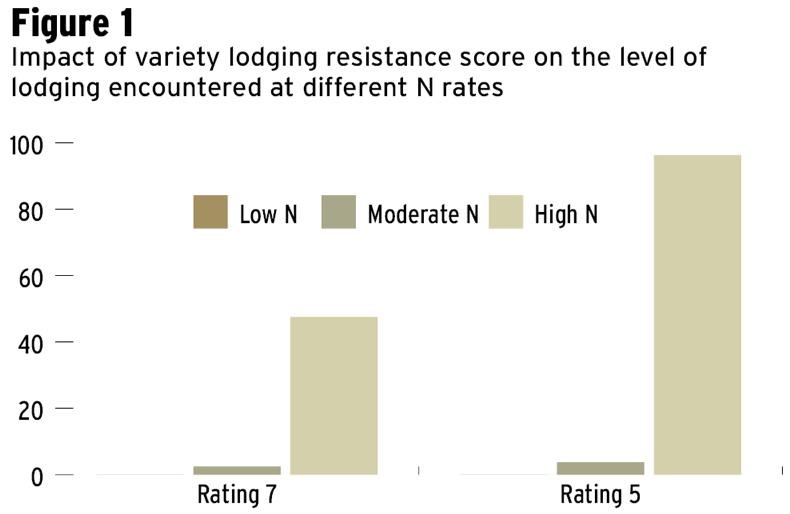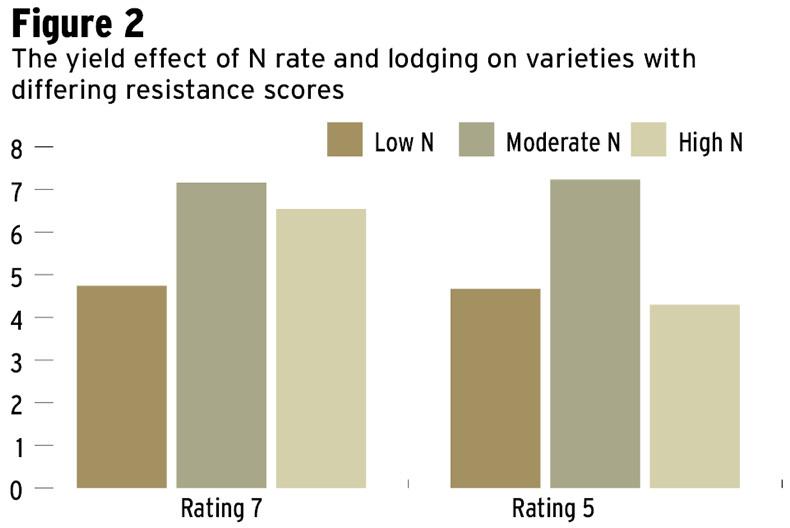The recent dry weather may have delayed the final application of N to spring barley crops, as growers wait for moisture to wash the fertiliser in. But before deciding to make that final application, it is worth considering if it is needed –particularly if growing malting barley.
Nitrogen rates for spring barley have increased over recent years in response to the low proteins in the 2009 to 2011 seasons. There are big seasonal variations in N supply from the soil. In wet, cold winters, most of the residual N from the previous season is washed out of the soil. Conversely, in warm, dry winters – like the one we have just experienced – there can be large reserves of N in the soil coming into the spring.
Crop yields in the previous year also have an effect: if crop yields in the previous year were high, they will have removed more N, leaving lower levels of residual N in the soil for this year’s crop.
When it comes to deciding on the correct N rate to apply, the previous crop and weather conditions need to be taken into account. This is especially relevant in the case of spring malting barley, where you are aiming for a relatively narrow grain protein target to maximise your grain price.
Grain protein is determined both by the N taken up by the crop and the grain yield, so crops with a low yield potential require less N – or you run the risk of not just low yield but also high protein.
The lodging risk
Another factor to consider is that most of the malting barley varieties we are growing at present have low resistance to lodging, with ratings of 5 on the DAFM recommended list. When growing such lodging-susceptible varieties, the application of excessively high rates of N increases the likelihood of lodging in a cereal crop. Lodging occurs when the force exerted on the aerial parts of a plant exceeds the strength of the stem base or root anchorage, and the plant is moved from its typical upright position.
Very high N applications and lodging are well related, as the typical responses to the nutrient’s application include an extension of shoot height, which increases the leverage force exerted on the base, and increases in shoot numbers, which can lead to a general reduction in stem strength and root anchorage, due to competition for resources.
When coupled with weather conditions, which further contribute to this imbalance between aerial force and base strength – such as high wind speeds or rainfall – the likelihood of crop lodging is substantially increased.
The impact of lodging on crop production can be quite variable and is affected by many factors. A lodged crop has reduced ability to utilise the radiation that it intercepts and, therefore, rates of growth can be severely affected. This can result in large negative impacts on grain filling and crop yield if lodging occurs at an early stage of grain filling.
Indeed, if grain filling is negatively affected it will most likely result in increased grain protein, a key quality parameter for malting barley. Furthermore, sections of crops that are badly lodged can create humid and warm environments around grain sites, which present favourable conditions for the development of mycotoxins and grain sprouting.
Lodged crops are also more susceptible to bird damage and can present significant harvest difficulties, which further contribute to yield losses. When these losses in yield and grain quality are accounted for – along with the cost of applied fertiliser that was not positively utilised – the effects of lodging on spring barley profitability can be substantial.
The variety factor
While N rate is a key factor that influences lodging, recent DAFM-funded research by AFBI and Teagasc has highlighted the role that variety selection can have in reducing risk of yield and margin losses in crops that have a high lodging risk.
Varieties selected for recommended lists in the Republic of Ireland and Northern Ireland are assessed and rated for resistance to lodging (or standing power).
As outlined in Figure 1, a trial conducted at AFBI’s Crossnacreevy site in 2014, which experienced weather conducive to lodging soon after crops reached GS71, observed increased lodging severity at GS75 for a variety with a low lodging resistance score (5 out of 9), compared to a variety with a high lodging resistance rating (7 out of 9).

These trials were grown using a high N application rate (240kg N/ha – an experimental rate to create high lodging pressure), with no significant difference found at low or moderate N application rates (40kg/h and 150kg/ha respectively, representing low lodging pressure).
The results presented in Figure 2 highlight the strong positive effect of the moderate N rate on yield compared to the low rate, driven by increases in grain numbers from the development of more shoots in the crop.

While the impact of lodging in the high-N-rate crop had a negative effect on both varieties, the negative effect was much more severe in the variety with a lower lodging resistance score. Indeed, the yield loss from the high N rate was almost 3t/ha on the low lodging resistance variety, compared to only 0.6t/ha for the variety with a high lodging resistance score.
Economic consequences
When feed grain and fertiliser prices for 2017 are considered, the estimated loss in potential margin over N cost for the more lodging-susceptible variety in the high-lodging-pressure environment was €318/ha greater than the more resistant variety in the same environment. And this is not accounting for the additional costs associated with the harvesting difficulties.
Indeed, the scale of this difference would be significantly greater if the reduced yield resulted in increased grain protein and loss of the malting premium.
While the high rates of N used in the study are above rates found on commercial farms, the lodging pressure created in the crop is likely similar to some spring barley crops in Ireland, especially crops grown with the “perfect storm” of high soil residual N content, high N application rates and weather that exerts a lot of force on the crop during grain filling.
Therefore, when determining N application rates for spring barley crops, it is important to consider the increased potential for crop lodging relative to the expected increase in yield, even for varieties with good lodging resistance.
However, varieties with poor lodging characteristics require much more consideration of the risk of yield and margin loss.






 This is a subscriber-only article
This is a subscriber-only article












SHARING OPTIONS: